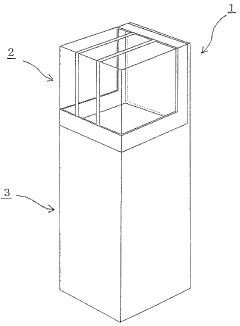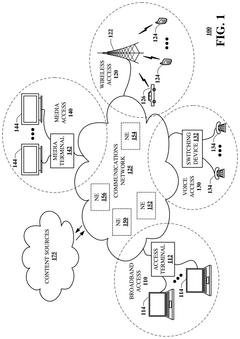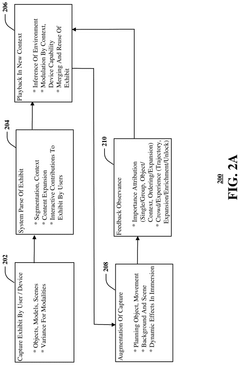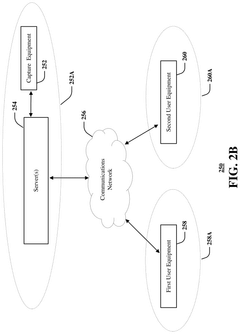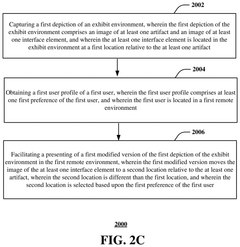Dolby Vision’s Influence on Immersive Exhibition Design
JUL 30, 20259 MIN READ
Generate Your Research Report Instantly with AI Agent
Patsnap Eureka helps you evaluate technical feasibility & market potential.
Dolby Vision Background and Objectives
Dolby Vision, a cutting-edge high dynamic range (HDR) imaging technology, has revolutionized the visual experience across various media platforms. Developed by Dolby Laboratories, this technology has its roots in the company's long-standing commitment to enhancing audio-visual experiences. The journey of Dolby Vision began in the early 2010s, building upon the foundation of HDR imaging techniques that had been evolving since the late 1990s.
The primary objective of Dolby Vision is to deliver a more lifelike and immersive visual experience by significantly expanding the range of brightness, contrast, and color that can be displayed on screens. This technology aims to bridge the gap between what the human eye can perceive in the real world and what traditional displays can reproduce, thereby creating a more authentic and engaging viewing experience.
As display technologies have advanced, Dolby Vision has continually evolved to push the boundaries of visual fidelity. The technology has expanded its reach from cinema screens to home entertainment systems, mobile devices, and now, immersive exhibition designs. This progression aligns with the broader trend of creating more interactive and engaging experiences in various sectors, including museums, art galleries, and educational institutions.
In the context of immersive exhibition design, Dolby Vision's objectives extend beyond mere visual enhancement. The technology seeks to transform how information is presented and absorbed in exhibition spaces, aiming to create more impactful and memorable experiences for visitors. By leveraging its superior color range, contrast, and brightness capabilities, Dolby Vision has the potential to bring exhibits to life in ways previously unattainable with standard display technologies.
The application of Dolby Vision in immersive exhibitions represents a convergence of entertainment technology and educational presentation methods. This intersection opens up new possibilities for storytelling, data visualization, and interactive learning experiences. The technology's ability to render fine details and subtle color gradations can be particularly valuable in exhibitions featuring historical artifacts, scientific phenomena, or artistic masterpieces.
Looking ahead, the objectives for Dolby Vision in immersive exhibition design include enhancing visitor engagement, improving information retention, and providing more accessible and inclusive experiences for diverse audiences. As the technology continues to evolve, it is expected to play a crucial role in shaping the future of exhibition design, potentially revolutionizing how we interact with and learn from curated environments.
The primary objective of Dolby Vision is to deliver a more lifelike and immersive visual experience by significantly expanding the range of brightness, contrast, and color that can be displayed on screens. This technology aims to bridge the gap between what the human eye can perceive in the real world and what traditional displays can reproduce, thereby creating a more authentic and engaging viewing experience.
As display technologies have advanced, Dolby Vision has continually evolved to push the boundaries of visual fidelity. The technology has expanded its reach from cinema screens to home entertainment systems, mobile devices, and now, immersive exhibition designs. This progression aligns with the broader trend of creating more interactive and engaging experiences in various sectors, including museums, art galleries, and educational institutions.
In the context of immersive exhibition design, Dolby Vision's objectives extend beyond mere visual enhancement. The technology seeks to transform how information is presented and absorbed in exhibition spaces, aiming to create more impactful and memorable experiences for visitors. By leveraging its superior color range, contrast, and brightness capabilities, Dolby Vision has the potential to bring exhibits to life in ways previously unattainable with standard display technologies.
The application of Dolby Vision in immersive exhibitions represents a convergence of entertainment technology and educational presentation methods. This intersection opens up new possibilities for storytelling, data visualization, and interactive learning experiences. The technology's ability to render fine details and subtle color gradations can be particularly valuable in exhibitions featuring historical artifacts, scientific phenomena, or artistic masterpieces.
Looking ahead, the objectives for Dolby Vision in immersive exhibition design include enhancing visitor engagement, improving information retention, and providing more accessible and inclusive experiences for diverse audiences. As the technology continues to evolve, it is expected to play a crucial role in shaping the future of exhibition design, potentially revolutionizing how we interact with and learn from curated environments.
Market Demand Analysis for Immersive Exhibitions
The immersive exhibition market has experienced significant growth in recent years, driven by increasing consumer demand for interactive and engaging experiences. Dolby Vision, with its advanced HDR technology, has emerged as a key player in enhancing the visual quality of these exhibitions, contributing to the overall market expansion.
Market research indicates that the global immersive exhibition market is projected to grow at a compound annual growth rate (CAGR) of over 20% in the next five years. This growth is fueled by the rising popularity of experiential marketing and the increasing adoption of cutting-edge technologies in museums, art galleries, and corporate showcases.
Dolby Vision's influence on immersive exhibitions has created a new standard for visual fidelity, driving demand for high-quality, lifelike displays. Consumers are increasingly seeking out exhibitions that offer superior color accuracy, contrast, and brightness, which Dolby Vision technology can provide. This has led to a surge in interest from exhibition organizers and venue operators looking to upgrade their visual systems to meet these heightened expectations.
The entertainment and education sectors have shown particular interest in Dolby Vision-enhanced immersive exhibitions. Museums and science centers are leveraging this technology to create more engaging and memorable experiences for visitors, while corporate events and product launches are utilizing it to showcase their offerings in the most visually appealing manner possible.
Furthermore, the COVID-19 pandemic has accelerated the adoption of virtual and hybrid exhibition formats, where high-quality visual experiences are crucial for audience engagement. Dolby Vision's ability to deliver superior image quality across various devices has positioned it as a valuable asset in this evolving landscape.
The market demand for Dolby Vision in immersive exhibitions extends beyond traditional indoor spaces. Outdoor installations, such as projection mapping on buildings and large-scale public art displays, are increasingly incorporating this technology to create stunning visual spectacles that captivate audiences and drive tourism.
As the demand for immersive experiences continues to grow, there is an increasing need for skilled professionals who can design and implement Dolby Vision-enhanced exhibitions. This has led to the emergence of specialized training programs and certifications, further indicating the technology's impact on the job market within the exhibition industry.
In conclusion, the market demand for Dolby Vision in immersive exhibition design is robust and expanding. The technology's ability to elevate visual experiences aligns well with consumer expectations for high-quality, engaging content. As the immersive exhibition market continues to evolve, Dolby Vision is poised to play a significant role in shaping its future trajectory and driving innovation in experiential design.
Market research indicates that the global immersive exhibition market is projected to grow at a compound annual growth rate (CAGR) of over 20% in the next five years. This growth is fueled by the rising popularity of experiential marketing and the increasing adoption of cutting-edge technologies in museums, art galleries, and corporate showcases.
Dolby Vision's influence on immersive exhibitions has created a new standard for visual fidelity, driving demand for high-quality, lifelike displays. Consumers are increasingly seeking out exhibitions that offer superior color accuracy, contrast, and brightness, which Dolby Vision technology can provide. This has led to a surge in interest from exhibition organizers and venue operators looking to upgrade their visual systems to meet these heightened expectations.
The entertainment and education sectors have shown particular interest in Dolby Vision-enhanced immersive exhibitions. Museums and science centers are leveraging this technology to create more engaging and memorable experiences for visitors, while corporate events and product launches are utilizing it to showcase their offerings in the most visually appealing manner possible.
Furthermore, the COVID-19 pandemic has accelerated the adoption of virtual and hybrid exhibition formats, where high-quality visual experiences are crucial for audience engagement. Dolby Vision's ability to deliver superior image quality across various devices has positioned it as a valuable asset in this evolving landscape.
The market demand for Dolby Vision in immersive exhibitions extends beyond traditional indoor spaces. Outdoor installations, such as projection mapping on buildings and large-scale public art displays, are increasingly incorporating this technology to create stunning visual spectacles that captivate audiences and drive tourism.
As the demand for immersive experiences continues to grow, there is an increasing need for skilled professionals who can design and implement Dolby Vision-enhanced exhibitions. This has led to the emergence of specialized training programs and certifications, further indicating the technology's impact on the job market within the exhibition industry.
In conclusion, the market demand for Dolby Vision in immersive exhibition design is robust and expanding. The technology's ability to elevate visual experiences aligns well with consumer expectations for high-quality, engaging content. As the immersive exhibition market continues to evolve, Dolby Vision is poised to play a significant role in shaping its future trajectory and driving innovation in experiential design.
Current State and Challenges of Dolby Vision in Exhibitions
Dolby Vision has made significant strides in the exhibition industry, revolutionizing the way visual content is displayed and experienced. Currently, this HDR technology is being adopted by leading museums, art galleries, and immersive exhibition spaces worldwide. Its ability to deliver a wider color gamut, higher contrast ratios, and enhanced brightness levels has set new standards for image quality in exhibition environments.
The implementation of Dolby Vision in exhibitions has led to more vibrant and lifelike displays, allowing artists and curators to present their work with unprecedented visual fidelity. This technology has particularly excelled in showcasing digital art, multimedia installations, and interactive exhibits, where color accuracy and dynamic range are crucial for conveying the artist's intent.
However, the widespread adoption of Dolby Vision in exhibition spaces faces several challenges. One of the primary obstacles is the high cost associated with Dolby Vision-compatible displays and projection systems. Many smaller galleries and museums struggle to justify the investment, especially when considering the need to upgrade existing infrastructure.
Another significant challenge is the limited availability of Dolby Vision-mastered content specifically created for exhibition purposes. While the technology excels in displaying HDR content, there is a scarcity of exhibition-ready material that fully utilizes Dolby Vision's capabilities. This gap necessitates additional effort and resources from curators and artists to create or adapt content for this format.
Technical expertise is also a hurdle in the implementation of Dolby Vision in exhibitions. The calibration and maintenance of Dolby Vision systems require specialized knowledge, which may not be readily available in many exhibition venues. This can lead to suboptimal performance or underutilization of the technology's full potential.
Furthermore, the integration of Dolby Vision with other exhibition technologies, such as interactive elements and immersive audio systems, presents both opportunities and challenges. While the combination of these technologies can create truly captivating experiences, ensuring seamless integration and synchronization can be complex and resource-intensive.
Lastly, the rapid pace of technological advancement in display technologies poses a challenge for long-term planning in exhibition design. As new standards and technologies emerge, there is a risk that investments in current Dolby Vision systems may become outdated relatively quickly, necessitating ongoing upgrades and adaptations.
Despite these challenges, the potential of Dolby Vision to enhance immersive exhibition experiences remains significant. As the technology matures and becomes more accessible, it is likely to play an increasingly important role in shaping the future of exhibition design and visual storytelling in cultural spaces.
The implementation of Dolby Vision in exhibitions has led to more vibrant and lifelike displays, allowing artists and curators to present their work with unprecedented visual fidelity. This technology has particularly excelled in showcasing digital art, multimedia installations, and interactive exhibits, where color accuracy and dynamic range are crucial for conveying the artist's intent.
However, the widespread adoption of Dolby Vision in exhibition spaces faces several challenges. One of the primary obstacles is the high cost associated with Dolby Vision-compatible displays and projection systems. Many smaller galleries and museums struggle to justify the investment, especially when considering the need to upgrade existing infrastructure.
Another significant challenge is the limited availability of Dolby Vision-mastered content specifically created for exhibition purposes. While the technology excels in displaying HDR content, there is a scarcity of exhibition-ready material that fully utilizes Dolby Vision's capabilities. This gap necessitates additional effort and resources from curators and artists to create or adapt content for this format.
Technical expertise is also a hurdle in the implementation of Dolby Vision in exhibitions. The calibration and maintenance of Dolby Vision systems require specialized knowledge, which may not be readily available in many exhibition venues. This can lead to suboptimal performance or underutilization of the technology's full potential.
Furthermore, the integration of Dolby Vision with other exhibition technologies, such as interactive elements and immersive audio systems, presents both opportunities and challenges. While the combination of these technologies can create truly captivating experiences, ensuring seamless integration and synchronization can be complex and resource-intensive.
Lastly, the rapid pace of technological advancement in display technologies poses a challenge for long-term planning in exhibition design. As new standards and technologies emerge, there is a risk that investments in current Dolby Vision systems may become outdated relatively quickly, necessitating ongoing upgrades and adaptations.
Despite these challenges, the potential of Dolby Vision to enhance immersive exhibition experiences remains significant. As the technology matures and becomes more accessible, it is likely to play an increasingly important role in shaping the future of exhibition design and visual storytelling in cultural spaces.
Existing Dolby Vision Implementation Strategies
01 Enhanced visual experience through Dolby Vision technology
Dolby Vision technology enhances the visual experience by providing high dynamic range (HDR) imaging, improved color depth, and brightness. This technology creates a more immersive viewing experience by offering greater contrast and a wider color gamut, resulting in more lifelike and vibrant images on compatible displays.- Enhanced visual experience through Dolby Vision technology: Dolby Vision technology enhances the visual experience by providing high dynamic range (HDR) imaging, improved color depth, and brightness. This technology creates a more immersive viewing experience by offering greater contrast and a wider color gamut, resulting in more lifelike and vibrant images on compatible displays.
- Audio-visual synchronization for immersive experience: Synchronizing audio with visual elements is crucial for creating an immersive Dolby Vision experience. This involves precise timing of sound effects, dialogue, and music to match on-screen action, enhancing the overall sense of realism and engagement for viewers.
- Optimized content creation and mastering for Dolby Vision: Content creators and filmmakers use specialized tools and techniques to optimize their work for Dolby Vision. This includes color grading, HDR mastering, and ensuring compatibility across various display devices to maintain the intended visual quality and immersiveness of the content.
- Display technology advancements for Dolby Vision: Advancements in display technology, such as OLED and QLED panels, contribute to the immersive experience of Dolby Vision content. These displays offer improved black levels, higher peak brightness, and wider color gamuts, allowing for a more accurate representation of Dolby Vision-enhanced content.
- Integration of Dolby Vision with other immersive technologies: Combining Dolby Vision with other immersive technologies, such as 3D audio systems and virtual reality, creates a more comprehensive and engaging entertainment experience. This integration enhances the sense of presence and realism for viewers, making content more captivating and memorable.
02 Audio-visual synchronization for immersive experience
Improved audio-visual synchronization techniques are employed to enhance the immersive experience in Dolby Vision content. These methods ensure that the audio perfectly aligns with the visual elements, creating a more realistic and engaging viewing experience for the audience.Expand Specific Solutions03 Advanced display technologies for Dolby Vision
Specialized display technologies are developed to fully utilize Dolby Vision capabilities. These may include improvements in LED backlighting, local dimming, and color processing to accurately reproduce the enhanced dynamic range and color information provided by Dolby Vision content.Expand Specific Solutions04 Content creation and mastering for Dolby Vision
Techniques and tools for creating and mastering content in Dolby Vision format are developed. These include specialized software, hardware, and workflows that allow content creators to take full advantage of the expanded color and dynamic range capabilities, ensuring that the final product delivers the intended immersive experience.Expand Specific Solutions05 Integration of Dolby Vision with other immersive technologies
Dolby Vision is integrated with other immersive technologies such as 3D audio, virtual reality, and augmented reality to create a more comprehensive and engaging experience. This combination of technologies aims to provide a multi-sensory, highly immersive environment for various applications including entertainment, education, and simulation.Expand Specific Solutions
Key Players in Dolby Vision and Exhibition Design
The competitive landscape for Dolby Vision's influence on immersive exhibition design is evolving rapidly as the industry enters a growth phase. The market size is expanding, driven by increasing demand for high-quality immersive experiences in entertainment and exhibition spaces. Technologically, the field is advancing but still maturing, with key players like Universal City Studios, Samsung Electronics, and Sony Group leading innovation. These companies are leveraging their expertise in audiovisual technologies to develop cutting-edge solutions that enhance immersion and visual quality. As the technology matures, we can expect increased competition and further advancements in immersive exhibition design capabilities.
Universal City Studios LLLP
Technical Solution: Universal has leveraged Dolby Vision technology in their theme parks and exhibitions to create highly immersive experiences. They have integrated Dolby Vision into their ride systems and exhibition spaces, combining high-quality visuals with motion and environmental effects[13]. Universal's approach focuses on storytelling, using Dolby Vision's enhanced contrast and color capabilities to create more emotionally impactful and immersive narratives. Their recent developments include the use of projection mapping techniques in conjunction with Dolby Vision to transform physical spaces into dynamic, interactive environments[14]. This approach allows for the creation of seamless, 360-degree immersive experiences that blur the line between the physical and digital worlds[15].
Strengths: Expertise in integrating technology with storytelling and physical environments, access to extensive IP library for content creation. Weaknesses: Solutions may be tailored to large-scale attractions, potentially less adaptable for smaller exhibition spaces.
Samsung Electronics Co., Ltd.
Technical Solution: Samsung has developed HDR10+ technology as an alternative to Dolby Vision, which is also applicable to immersive exhibition design. HDR10+ uses dynamic metadata to optimize picture quality on a scene-by-scene or frame-by-frame basis[10]. For exhibitions, Samsung's The Wall series of MicroLED displays offers modular, scalable solutions with exceptional brightness (up to 2000 nits) and deep blacks, suitable for creating large-scale immersive environments[11]. Samsung has also introduced AI-powered upscaling technology that can enhance lower resolution content to near-4K or 8K quality, which is particularly useful for displaying archival or diverse source materials in exhibitions[12].
Strengths: Versatile display technologies suitable for various exhibition scales, open HDR standard (HDR10+). Weaknesses: Lack of native Dolby Vision support may limit compatibility with some content.
Core Innovations in Dolby Vision for Exhibitions
Exhibition case
PatentWO2006135070A1
Innovation
- A display case with a variable transmittance panel and LED lighting system, controlled by a device that synchronizes light and sound to create an immersive experience, using a composite panel of transparent plastic and liquid crystal layers, and sound reproduction devices to adjust lighting and sound in synchronization with exhibit content.
Systems and methods for facilitating immersive exhibits
PatentPendingUS20250037384A1
Innovation
- The system captures 3D depictions of exhibit environments and objects, allowing for strategic playback and rendering with real-time user interaction, and enables interactive engagement with immersive environments and co-participants, accommodating user preferences and hardware limitations.
Content Creation Pipeline for Dolby Vision Exhibitions
The content creation pipeline for Dolby Vision exhibitions represents a sophisticated workflow designed to leverage the full potential of this advanced HDR technology in immersive display environments. This process begins with the capture of high-quality, wide color gamut footage using cameras capable of recording in Dolby Vision or compatible HDR formats. Cinematographers and directors must carefully consider lighting, color grading, and dynamic range to fully exploit the technology's capabilities.
Post-production plays a crucial role in the Dolby Vision pipeline. Editors and colorists work with specialized software tools that support Dolby Vision's metadata-driven approach to HDR. This allows for precise control over brightness, color, and contrast across a wide range of display capabilities. The Dolby Vision content mapping process ensures that the creative intent is preserved across various devices, from high-end cinema projectors to consumer-grade displays.
For exhibitions, content creators must consider the unique characteristics of the display environment. This may involve custom calibration processes to ensure that the Dolby Vision content is optimized for the specific projection or display systems used in the exhibition space. Attention must be paid to ambient lighting conditions, screen materials, and viewing angles to maximize the impact of the enhanced dynamic range and color volume.
Interactive elements in exhibitions present both challenges and opportunities for Dolby Vision content. Developers must ensure that real-time rendering engines can accurately process and display Dolby Vision metadata, maintaining the intended visual quality in interactive scenarios. This may require close collaboration between content creators, software engineers, and Dolby Vision specialists to develop custom solutions that fully utilize the technology's potential in non-linear content.
Audio integration is another critical aspect of the content creation pipeline for Dolby Vision exhibitions. While Dolby Vision primarily focuses on visual enhancements, its implementation often goes hand-in-hand with advanced audio technologies like Dolby Atmos. Content creators must consider how the enhanced visual experience can be complemented by immersive audio, ensuring a cohesive and engaging multi-sensory experience for exhibition visitors.
Finally, the content delivery and playback systems must be carefully designed to maintain the integrity of the Dolby Vision signal throughout the exhibition. This involves selecting appropriate media servers, transmission protocols, and playback devices that can accurately interpret and display Dolby Vision content. Quality control processes are essential to verify that the final exhibited content faithfully reproduces the creator's artistic vision, leveraging the full potential of Dolby Vision technology to create truly immersive and impactful exhibition experiences.
Post-production plays a crucial role in the Dolby Vision pipeline. Editors and colorists work with specialized software tools that support Dolby Vision's metadata-driven approach to HDR. This allows for precise control over brightness, color, and contrast across a wide range of display capabilities. The Dolby Vision content mapping process ensures that the creative intent is preserved across various devices, from high-end cinema projectors to consumer-grade displays.
For exhibitions, content creators must consider the unique characteristics of the display environment. This may involve custom calibration processes to ensure that the Dolby Vision content is optimized for the specific projection or display systems used in the exhibition space. Attention must be paid to ambient lighting conditions, screen materials, and viewing angles to maximize the impact of the enhanced dynamic range and color volume.
Interactive elements in exhibitions present both challenges and opportunities for Dolby Vision content. Developers must ensure that real-time rendering engines can accurately process and display Dolby Vision metadata, maintaining the intended visual quality in interactive scenarios. This may require close collaboration between content creators, software engineers, and Dolby Vision specialists to develop custom solutions that fully utilize the technology's potential in non-linear content.
Audio integration is another critical aspect of the content creation pipeline for Dolby Vision exhibitions. While Dolby Vision primarily focuses on visual enhancements, its implementation often goes hand-in-hand with advanced audio technologies like Dolby Atmos. Content creators must consider how the enhanced visual experience can be complemented by immersive audio, ensuring a cohesive and engaging multi-sensory experience for exhibition visitors.
Finally, the content delivery and playback systems must be carefully designed to maintain the integrity of the Dolby Vision signal throughout the exhibition. This involves selecting appropriate media servers, transmission protocols, and playback devices that can accurately interpret and display Dolby Vision content. Quality control processes are essential to verify that the final exhibited content faithfully reproduces the creator's artistic vision, leveraging the full potential of Dolby Vision technology to create truly immersive and impactful exhibition experiences.
Audience Experience and Engagement Metrics
Dolby Vision's impact on audience experience and engagement metrics in immersive exhibition design has been profound and multifaceted. The technology's ability to deliver enhanced contrast, brightness, and color accuracy has significantly elevated the visual quality of exhibitions, leading to more captivating and memorable experiences for visitors.
One of the primary metrics affected by Dolby Vision is visitor dwell time. Exhibitions incorporating this technology have reported increased average time spent by visitors engaging with displays and installations. The enhanced visual fidelity encourages deeper exploration and contemplation of exhibited content, resulting in longer engagement periods and potentially improved knowledge retention.
Emotional response measurements have also shown notable improvements in exhibitions utilizing Dolby Vision. Surveys and biometric data indicate higher levels of excitement, awe, and satisfaction among visitors exposed to Dolby Vision-enhanced displays. This emotional engagement is crucial for creating lasting impressions and fostering a connection between the audience and the exhibited material.
Interactive elements within exhibitions have benefited from Dolby Vision's capabilities as well. Touch screens and motion-sensitive displays leveraging the technology's wide color gamut and high dynamic range have demonstrated increased user interaction rates. The vivid and lifelike representations encourage more frequent and prolonged interactions with digital exhibits, enhancing the overall participatory nature of modern exhibitions.
Social media engagement metrics have seen a positive trend in exhibitions featuring Dolby Vision. The visually striking nature of the displays often prompts visitors to share their experiences on various platforms, increasing the exhibition's organic reach and attracting new audiences. This digital word-of-mouth effect has become an invaluable tool for exhibition promoters and curators.
Accessibility metrics have also improved with the implementation of Dolby Vision. The technology's ability to render fine details and subtle color gradations has made exhibitions more inclusive for visitors with visual impairments. This has led to higher satisfaction rates among diverse audience groups and aligns with the growing emphasis on creating universally accessible cultural experiences.
Return visitor rates have shown an uptick in venues that have adopted Dolby Vision for their immersive exhibitions. The promise of a visually superior experience encourages repeat visits, especially for temporary or rotating exhibitions. This not only boosts ticket sales but also fosters a loyal visitor base that can contribute to the long-term sustainability of exhibition spaces.
One of the primary metrics affected by Dolby Vision is visitor dwell time. Exhibitions incorporating this technology have reported increased average time spent by visitors engaging with displays and installations. The enhanced visual fidelity encourages deeper exploration and contemplation of exhibited content, resulting in longer engagement periods and potentially improved knowledge retention.
Emotional response measurements have also shown notable improvements in exhibitions utilizing Dolby Vision. Surveys and biometric data indicate higher levels of excitement, awe, and satisfaction among visitors exposed to Dolby Vision-enhanced displays. This emotional engagement is crucial for creating lasting impressions and fostering a connection between the audience and the exhibited material.
Interactive elements within exhibitions have benefited from Dolby Vision's capabilities as well. Touch screens and motion-sensitive displays leveraging the technology's wide color gamut and high dynamic range have demonstrated increased user interaction rates. The vivid and lifelike representations encourage more frequent and prolonged interactions with digital exhibits, enhancing the overall participatory nature of modern exhibitions.
Social media engagement metrics have seen a positive trend in exhibitions featuring Dolby Vision. The visually striking nature of the displays often prompts visitors to share their experiences on various platforms, increasing the exhibition's organic reach and attracting new audiences. This digital word-of-mouth effect has become an invaluable tool for exhibition promoters and curators.
Accessibility metrics have also improved with the implementation of Dolby Vision. The technology's ability to render fine details and subtle color gradations has made exhibitions more inclusive for visitors with visual impairments. This has led to higher satisfaction rates among diverse audience groups and aligns with the growing emphasis on creating universally accessible cultural experiences.
Return visitor rates have shown an uptick in venues that have adopted Dolby Vision for their immersive exhibitions. The promise of a visually superior experience encourages repeat visits, especially for temporary or rotating exhibitions. This not only boosts ticket sales but also fosters a loyal visitor base that can contribute to the long-term sustainability of exhibition spaces.
Unlock deeper insights with Patsnap Eureka Quick Research — get a full tech report to explore trends and direct your research. Try now!
Generate Your Research Report Instantly with AI Agent
Supercharge your innovation with Patsnap Eureka AI Agent Platform!
